Performance Analysis of Ground Source Heat Pumps (GSHP)
VerifiedAdded on 2023/04/23
|16
|3893
|400
Report
AI Summary
This report, a mechanical engineering analysis of ground source heat pumps (GSHP), investigates their performance, types, and operational efficiency in residential applications. It examines the performance coefficients, costs, and the impact of various parameters on GSHP systems. The report includes a literature review, research questions, and aims to evaluate the performance of GSHP systems, focusing on temperature, humidity, and other relevant factors. It also explores the challenges faced by existing GSHP systems and provides recommendations for enhancing their performance. The study includes an overview of closed-loop systems, limitations, and a discussion of the overall system and heat coefficient of performance, as well as the seasonal energy efficiency ratio. The report offers valuable insights into the application and efficiency of GSHP systems.

MECHANICAL ENGEINEERING MANAGEMENT
By Name
Course
Instructor
Institution
Location
Date
By Name
Course
Instructor
Institution
Location
Date
Paraphrase This Document
Need a fresh take? Get an instant paraphrase of this document with our AI Paraphraser
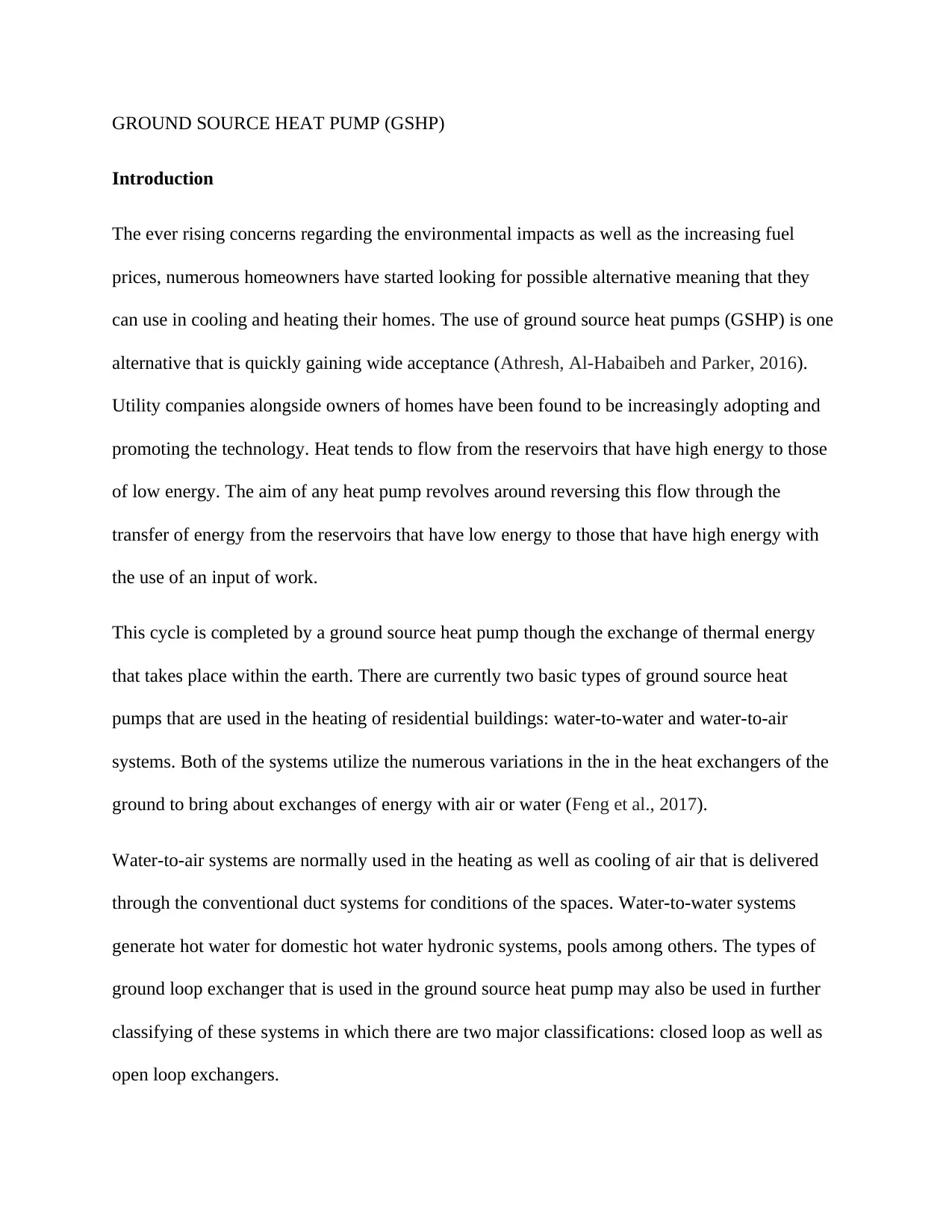
GROUND SOURCE HEAT PUMP (GSHP)
Introduction
The ever rising concerns regarding the environmental impacts as well as the increasing fuel
prices, numerous homeowners have started looking for possible alternative meaning that they
can use in cooling and heating their homes. The use of ground source heat pumps (GSHP) is one
alternative that is quickly gaining wide acceptance (Athresh, Al-Habaibeh and Parker, 2016).
Utility companies alongside owners of homes have been found to be increasingly adopting and
promoting the technology. Heat tends to flow from the reservoirs that have high energy to those
of low energy. The aim of any heat pump revolves around reversing this flow through the
transfer of energy from the reservoirs that have low energy to those that have high energy with
the use of an input of work.
This cycle is completed by a ground source heat pump though the exchange of thermal energy
that takes place within the earth. There are currently two basic types of ground source heat
pumps that are used in the heating of residential buildings: water-to-water and water-to-air
systems. Both of the systems utilize the numerous variations in the in the heat exchangers of the
ground to bring about exchanges of energy with air or water (Feng et al., 2017).
Water-to-air systems are normally used in the heating as well as cooling of air that is delivered
through the conventional duct systems for conditions of the spaces. Water-to-water systems
generate hot water for domestic hot water hydronic systems, pools among others. The types of
ground loop exchanger that is used in the ground source heat pump may also be used in further
classifying of these systems in which there are two major classifications: closed loop as well as
open loop exchangers.
Introduction
The ever rising concerns regarding the environmental impacts as well as the increasing fuel
prices, numerous homeowners have started looking for possible alternative meaning that they
can use in cooling and heating their homes. The use of ground source heat pumps (GSHP) is one
alternative that is quickly gaining wide acceptance (Athresh, Al-Habaibeh and Parker, 2016).
Utility companies alongside owners of homes have been found to be increasingly adopting and
promoting the technology. Heat tends to flow from the reservoirs that have high energy to those
of low energy. The aim of any heat pump revolves around reversing this flow through the
transfer of energy from the reservoirs that have low energy to those that have high energy with
the use of an input of work.
This cycle is completed by a ground source heat pump though the exchange of thermal energy
that takes place within the earth. There are currently two basic types of ground source heat
pumps that are used in the heating of residential buildings: water-to-water and water-to-air
systems. Both of the systems utilize the numerous variations in the in the heat exchangers of the
ground to bring about exchanges of energy with air or water (Feng et al., 2017).
Water-to-air systems are normally used in the heating as well as cooling of air that is delivered
through the conventional duct systems for conditions of the spaces. Water-to-water systems
generate hot water for domestic hot water hydronic systems, pools among others. The types of
ground loop exchanger that is used in the ground source heat pump may also be used in further
classifying of these systems in which there are two major classifications: closed loop as well as
open loop exchangers.
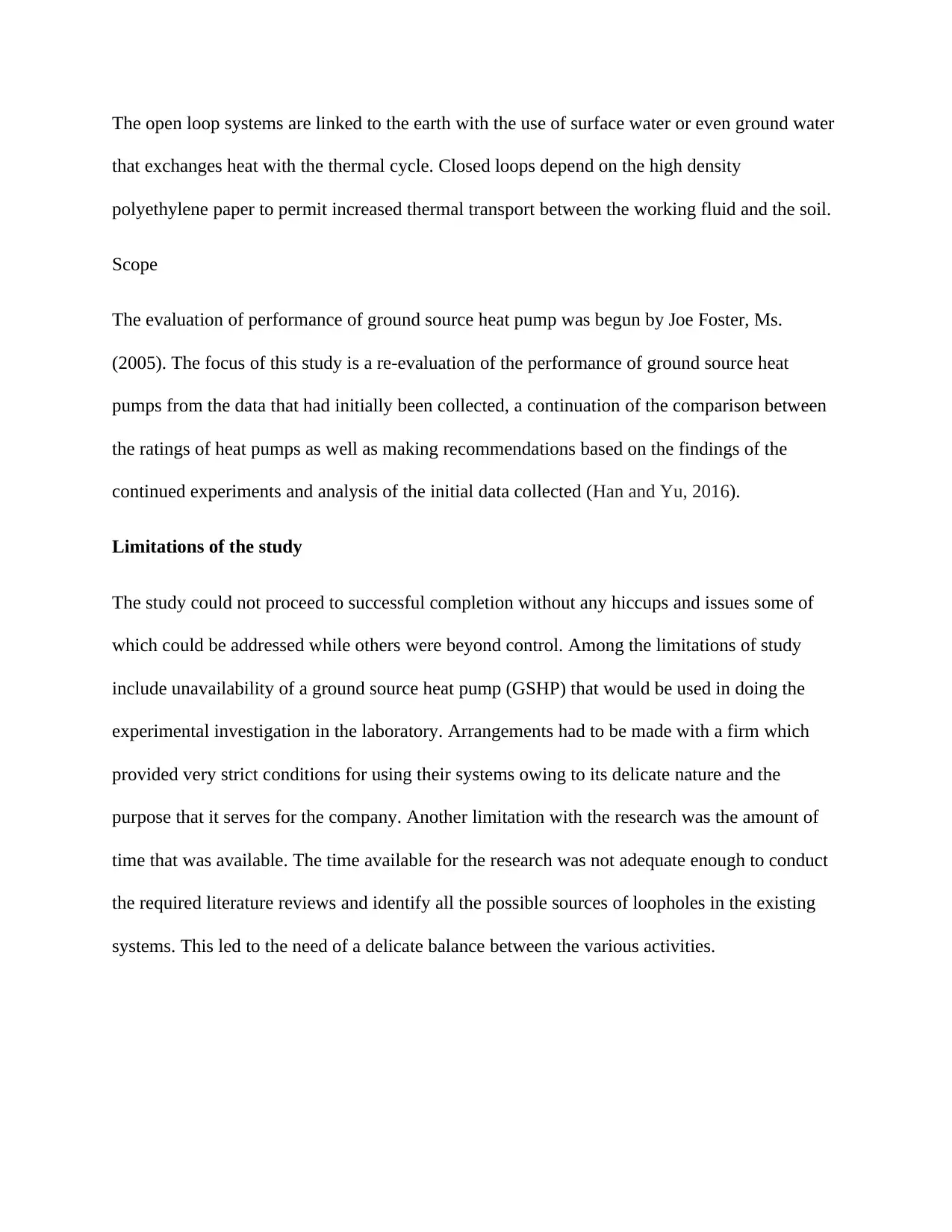
The open loop systems are linked to the earth with the use of surface water or even ground water
that exchanges heat with the thermal cycle. Closed loops depend on the high density
polyethylene paper to permit increased thermal transport between the working fluid and the soil.
Scope
The evaluation of performance of ground source heat pump was begun by Joe Foster, Ms.
(2005). The focus of this study is a re-evaluation of the performance of ground source heat
pumps from the data that had initially been collected, a continuation of the comparison between
the ratings of heat pumps as well as making recommendations based on the findings of the
continued experiments and analysis of the initial data collected (Han and Yu, 2016).
Limitations of the study
The study could not proceed to successful completion without any hiccups and issues some of
which could be addressed while others were beyond control. Among the limitations of study
include unavailability of a ground source heat pump (GSHP) that would be used in doing the
experimental investigation in the laboratory. Arrangements had to be made with a firm which
provided very strict conditions for using their systems owing to its delicate nature and the
purpose that it serves for the company. Another limitation with the research was the amount of
time that was available. The time available for the research was not adequate enough to conduct
the required literature reviews and identify all the possible sources of loopholes in the existing
systems. This led to the need of a delicate balance between the various activities.
that exchanges heat with the thermal cycle. Closed loops depend on the high density
polyethylene paper to permit increased thermal transport between the working fluid and the soil.
Scope
The evaluation of performance of ground source heat pump was begun by Joe Foster, Ms.
(2005). The focus of this study is a re-evaluation of the performance of ground source heat
pumps from the data that had initially been collected, a continuation of the comparison between
the ratings of heat pumps as well as making recommendations based on the findings of the
continued experiments and analysis of the initial data collected (Han and Yu, 2016).
Limitations of the study
The study could not proceed to successful completion without any hiccups and issues some of
which could be addressed while others were beyond control. Among the limitations of study
include unavailability of a ground source heat pump (GSHP) that would be used in doing the
experimental investigation in the laboratory. Arrangements had to be made with a firm which
provided very strict conditions for using their systems owing to its delicate nature and the
purpose that it serves for the company. Another limitation with the research was the amount of
time that was available. The time available for the research was not adequate enough to conduct
the required literature reviews and identify all the possible sources of loopholes in the existing
systems. This led to the need of a delicate balance between the various activities.
⊘ This is a preview!⊘
Do you want full access?
Subscribe today to unlock all pages.

Trusted by 1+ million students worldwide

Statement Aims
The main aim of the study is to investigate the performance of ground source heat pump with
regard to the various parameters including temperature, relative humidity and among other
parameters.
The objectives include:
Conducting an investigation of the various types of ground source heat pump systems and
their operations
Evaluating the performance of ground source heat pump with regard to costs
Establish the impacts of various parameters on the performance of ground source heat
pump
Making recommendations on how to enhance the performance of ground source heat
pump based on the analysis of the findings
Statement of Problem
In as much as numerous studies and researches have been carried out and availed with regard to
Ground Source Heat Pumps, there are few researches that have been done regarding applications
of Ground Source Heat Pump in residential structures as well as the evaluation of the
performance coefficience alongside the system efficiency. The use of Ground Source Heat Pump
with vertical closed loop systems for applications in residential buildings has been evaluated and
the process explained in brief.
Various sensors, a data acquisition systems as well as a control systems that is made up of a
computer is used and installed at various locations on the systems, the outlet and inlet
temperatures of purpose, wells temperature, room temperature, system power, outside and inside
The main aim of the study is to investigate the performance of ground source heat pump with
regard to the various parameters including temperature, relative humidity and among other
parameters.
The objectives include:
Conducting an investigation of the various types of ground source heat pump systems and
their operations
Evaluating the performance of ground source heat pump with regard to costs
Establish the impacts of various parameters on the performance of ground source heat
pump
Making recommendations on how to enhance the performance of ground source heat
pump based on the analysis of the findings
Statement of Problem
In as much as numerous studies and researches have been carried out and availed with regard to
Ground Source Heat Pumps, there are few researches that have been done regarding applications
of Ground Source Heat Pump in residential structures as well as the evaluation of the
performance coefficience alongside the system efficiency. The use of Ground Source Heat Pump
with vertical closed loop systems for applications in residential buildings has been evaluated and
the process explained in brief.
Various sensors, a data acquisition systems as well as a control systems that is made up of a
computer is used and installed at various locations on the systems, the outlet and inlet
temperatures of purpose, wells temperature, room temperature, system power, outside and inside
Paraphrase This Document
Need a fresh take? Get an instant paraphrase of this document with our AI Paraphraser
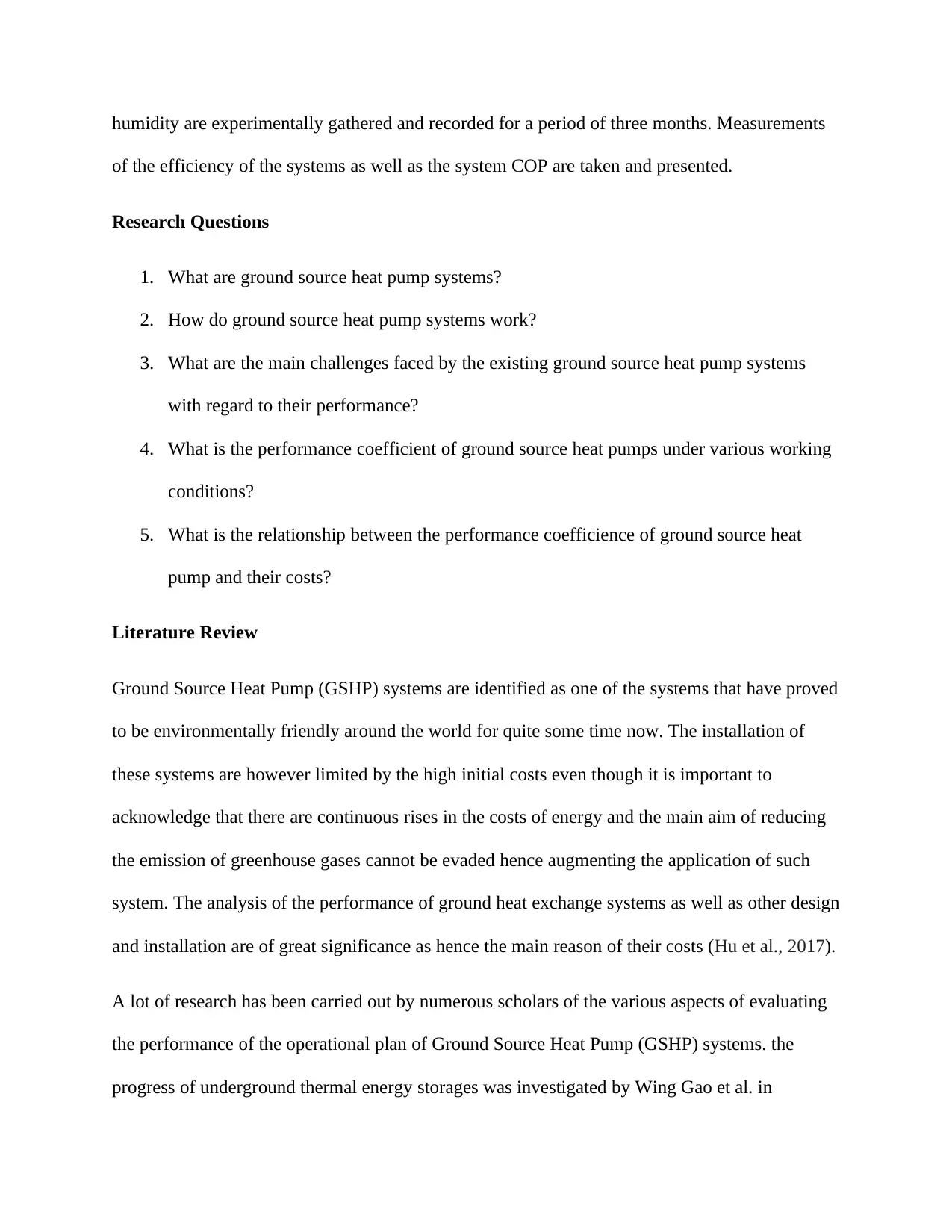
humidity are experimentally gathered and recorded for a period of three months. Measurements
of the efficiency of the systems as well as the system COP are taken and presented.
Research Questions
1. What are ground source heat pump systems?
2. How do ground source heat pump systems work?
3. What are the main challenges faced by the existing ground source heat pump systems
with regard to their performance?
4. What is the performance coefficient of ground source heat pumps under various working
conditions?
5. What is the relationship between the performance coefficience of ground source heat
pump and their costs?
Literature Review
Ground Source Heat Pump (GSHP) systems are identified as one of the systems that have proved
to be environmentally friendly around the world for quite some time now. The installation of
these systems are however limited by the high initial costs even though it is important to
acknowledge that there are continuous rises in the costs of energy and the main aim of reducing
the emission of greenhouse gases cannot be evaded hence augmenting the application of such
system. The analysis of the performance of ground heat exchange systems as well as other design
and installation are of great significance as hence the main reason of their costs (Hu et al., 2017).
A lot of research has been carried out by numerous scholars of the various aspects of evaluating
the performance of the operational plan of Ground Source Heat Pump (GSHP) systems. the
progress of underground thermal energy storages was investigated by Wing Gao et al. in
of the efficiency of the systems as well as the system COP are taken and presented.
Research Questions
1. What are ground source heat pump systems?
2. How do ground source heat pump systems work?
3. What are the main challenges faced by the existing ground source heat pump systems
with regard to their performance?
4. What is the performance coefficient of ground source heat pumps under various working
conditions?
5. What is the relationship between the performance coefficience of ground source heat
pump and their costs?
Literature Review
Ground Source Heat Pump (GSHP) systems are identified as one of the systems that have proved
to be environmentally friendly around the world for quite some time now. The installation of
these systems are however limited by the high initial costs even though it is important to
acknowledge that there are continuous rises in the costs of energy and the main aim of reducing
the emission of greenhouse gases cannot be evaded hence augmenting the application of such
system. The analysis of the performance of ground heat exchange systems as well as other design
and installation are of great significance as hence the main reason of their costs (Hu et al., 2017).
A lot of research has been carried out by numerous scholars of the various aspects of evaluating
the performance of the operational plan of Ground Source Heat Pump (GSHP) systems. the
progress of underground thermal energy storages was investigated by Wing Gao et al. in
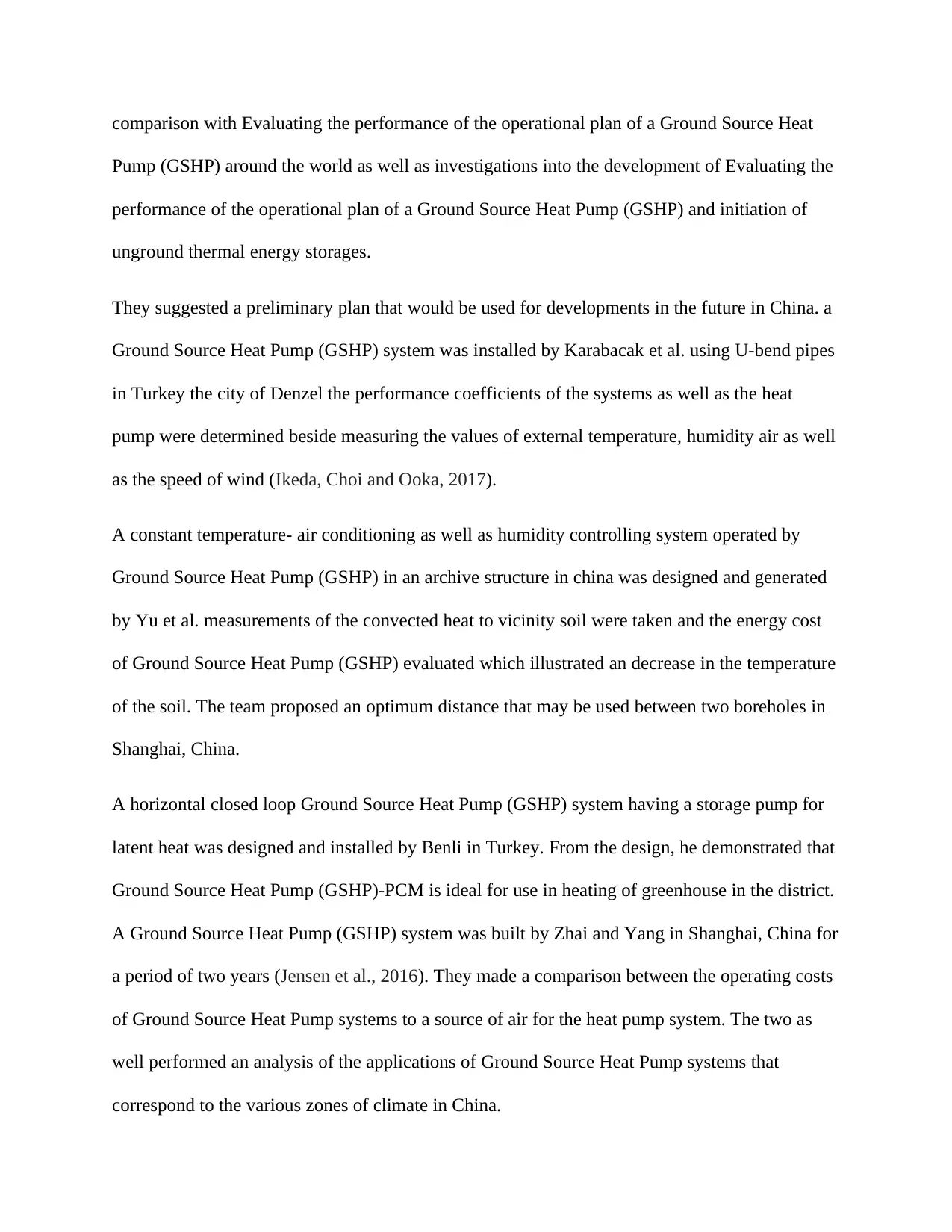
comparison with Evaluating the performance of the operational plan of a Ground Source Heat
Pump (GSHP) around the world as well as investigations into the development of Evaluating the
performance of the operational plan of a Ground Source Heat Pump (GSHP) and initiation of
unground thermal energy storages.
They suggested a preliminary plan that would be used for developments in the future in China. a
Ground Source Heat Pump (GSHP) system was installed by Karabacak et al. using U-bend pipes
in Turkey the city of Denzel the performance coefficients of the systems as well as the heat
pump were determined beside measuring the values of external temperature, humidity air as well
as the speed of wind (Ikeda, Choi and Ooka, 2017).
A constant temperature- air conditioning as well as humidity controlling system operated by
Ground Source Heat Pump (GSHP) in an archive structure in china was designed and generated
by Yu et al. measurements of the convected heat to vicinity soil were taken and the energy cost
of Ground Source Heat Pump (GSHP) evaluated which illustrated an decrease in the temperature
of the soil. The team proposed an optimum distance that may be used between two boreholes in
Shanghai, China.
A horizontal closed loop Ground Source Heat Pump (GSHP) system having a storage pump for
latent heat was designed and installed by Benli in Turkey. From the design, he demonstrated that
Ground Source Heat Pump (GSHP)-PCM is ideal for use in heating of greenhouse in the district.
A Ground Source Heat Pump (GSHP) system was built by Zhai and Yang in Shanghai, China for
a period of two years (Jensen et al., 2016). They made a comparison between the operating costs
of Ground Source Heat Pump systems to a source of air for the heat pump system. The two as
well performed an analysis of the applications of Ground Source Heat Pump systems that
correspond to the various zones of climate in China.
Pump (GSHP) around the world as well as investigations into the development of Evaluating the
performance of the operational plan of a Ground Source Heat Pump (GSHP) and initiation of
unground thermal energy storages.
They suggested a preliminary plan that would be used for developments in the future in China. a
Ground Source Heat Pump (GSHP) system was installed by Karabacak et al. using U-bend pipes
in Turkey the city of Denzel the performance coefficients of the systems as well as the heat
pump were determined beside measuring the values of external temperature, humidity air as well
as the speed of wind (Ikeda, Choi and Ooka, 2017).
A constant temperature- air conditioning as well as humidity controlling system operated by
Ground Source Heat Pump (GSHP) in an archive structure in china was designed and generated
by Yu et al. measurements of the convected heat to vicinity soil were taken and the energy cost
of Ground Source Heat Pump (GSHP) evaluated which illustrated an decrease in the temperature
of the soil. The team proposed an optimum distance that may be used between two boreholes in
Shanghai, China.
A horizontal closed loop Ground Source Heat Pump (GSHP) system having a storage pump for
latent heat was designed and installed by Benli in Turkey. From the design, he demonstrated that
Ground Source Heat Pump (GSHP)-PCM is ideal for use in heating of greenhouse in the district.
A Ground Source Heat Pump (GSHP) system was built by Zhai and Yang in Shanghai, China for
a period of two years (Jensen et al., 2016). They made a comparison between the operating costs
of Ground Source Heat Pump systems to a source of air for the heat pump system. The two as
well performed an analysis of the applications of Ground Source Heat Pump systems that
correspond to the various zones of climate in China.
⊘ This is a preview!⊘
Do you want full access?
Subscribe today to unlock all pages.

Trusted by 1+ million students worldwide
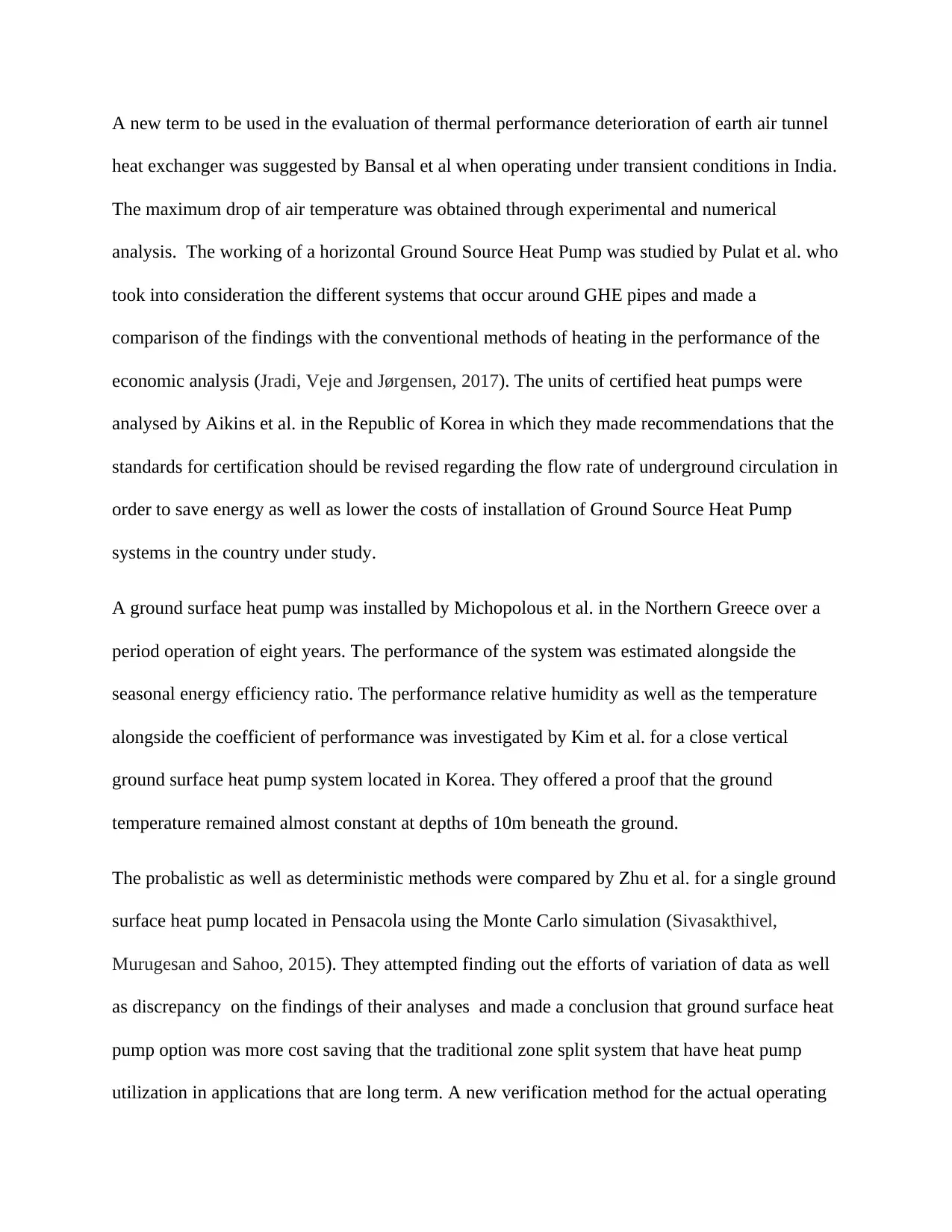
A new term to be used in the evaluation of thermal performance deterioration of earth air tunnel
heat exchanger was suggested by Bansal et al when operating under transient conditions in India.
The maximum drop of air temperature was obtained through experimental and numerical
analysis. The working of a horizontal Ground Source Heat Pump was studied by Pulat et al. who
took into consideration the different systems that occur around GHE pipes and made a
comparison of the findings with the conventional methods of heating in the performance of the
economic analysis (Jradi, Veje and Jørgensen, 2017). The units of certified heat pumps were
analysed by Aikins et al. in the Republic of Korea in which they made recommendations that the
standards for certification should be revised regarding the flow rate of underground circulation in
order to save energy as well as lower the costs of installation of Ground Source Heat Pump
systems in the country under study.
A ground surface heat pump was installed by Michopolous et al. in the Northern Greece over a
period operation of eight years. The performance of the system was estimated alongside the
seasonal energy efficiency ratio. The performance relative humidity as well as the temperature
alongside the coefficient of performance was investigated by Kim et al. for a close vertical
ground surface heat pump system located in Korea. They offered a proof that the ground
temperature remained almost constant at depths of 10m beneath the ground.
The probalistic as well as deterministic methods were compared by Zhu et al. for a single ground
surface heat pump located in Pensacola using the Monte Carlo simulation (Sivasakthivel,
Murugesan and Sahoo, 2015). They attempted finding out the efforts of variation of data as well
as discrepancy on the findings of their analyses and made a conclusion that ground surface heat
pump option was more cost saving that the traditional zone split system that have heat pump
utilization in applications that are long term. A new verification method for the actual operating
heat exchanger was suggested by Bansal et al when operating under transient conditions in India.
The maximum drop of air temperature was obtained through experimental and numerical
analysis. The working of a horizontal Ground Source Heat Pump was studied by Pulat et al. who
took into consideration the different systems that occur around GHE pipes and made a
comparison of the findings with the conventional methods of heating in the performance of the
economic analysis (Jradi, Veje and Jørgensen, 2017). The units of certified heat pumps were
analysed by Aikins et al. in the Republic of Korea in which they made recommendations that the
standards for certification should be revised regarding the flow rate of underground circulation in
order to save energy as well as lower the costs of installation of Ground Source Heat Pump
systems in the country under study.
A ground surface heat pump was installed by Michopolous et al. in the Northern Greece over a
period operation of eight years. The performance of the system was estimated alongside the
seasonal energy efficiency ratio. The performance relative humidity as well as the temperature
alongside the coefficient of performance was investigated by Kim et al. for a close vertical
ground surface heat pump system located in Korea. They offered a proof that the ground
temperature remained almost constant at depths of 10m beneath the ground.
The probalistic as well as deterministic methods were compared by Zhu et al. for a single ground
surface heat pump located in Pensacola using the Monte Carlo simulation (Sivasakthivel,
Murugesan and Sahoo, 2015). They attempted finding out the efforts of variation of data as well
as discrepancy on the findings of their analyses and made a conclusion that ground surface heat
pump option was more cost saving that the traditional zone split system that have heat pump
utilization in applications that are long term. A new verification method for the actual operating
Paraphrase This Document
Need a fresh take? Get an instant paraphrase of this document with our AI Paraphraser
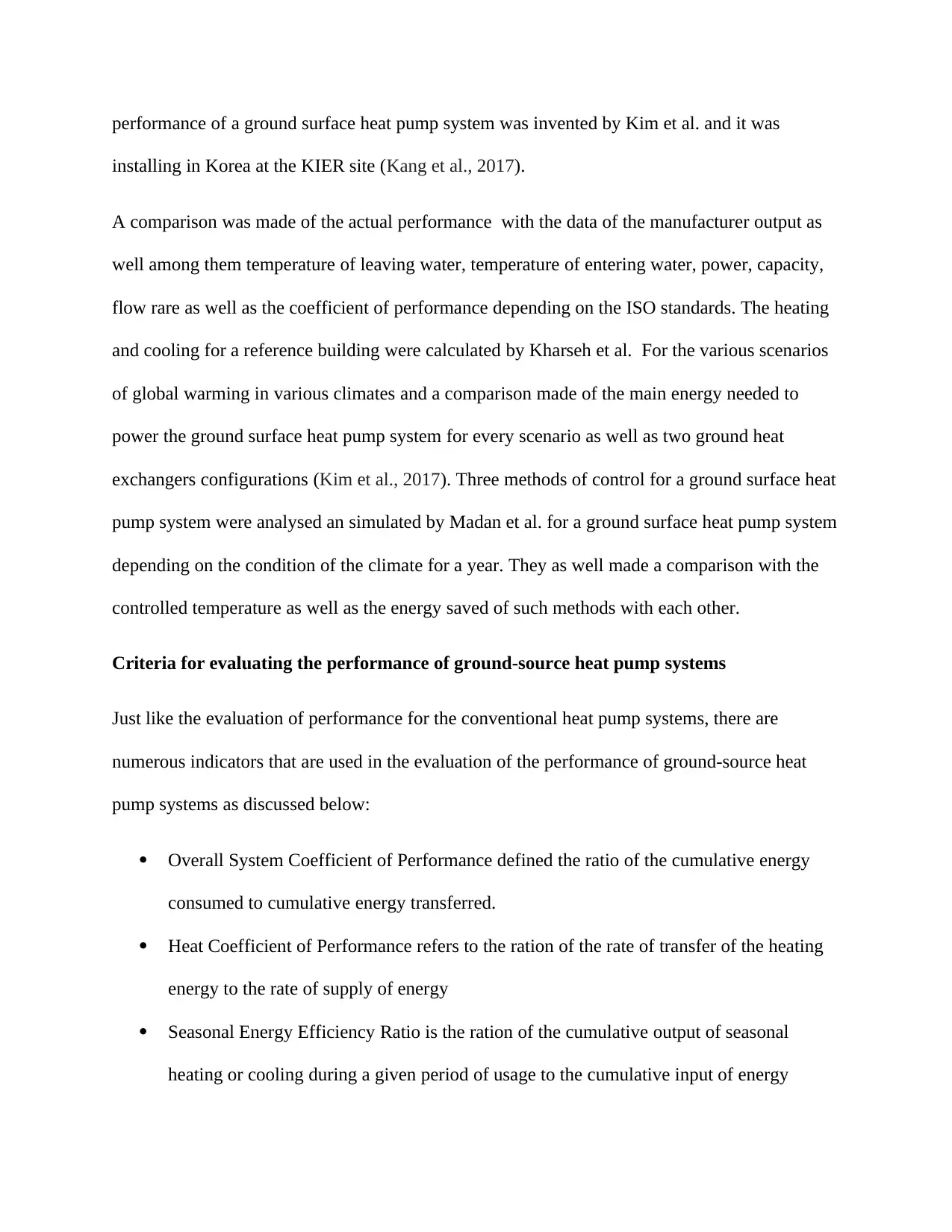
performance of a ground surface heat pump system was invented by Kim et al. and it was
installing in Korea at the KIER site (Kang et al., 2017).
A comparison was made of the actual performance with the data of the manufacturer output as
well among them temperature of leaving water, temperature of entering water, power, capacity,
flow rare as well as the coefficient of performance depending on the ISO standards. The heating
and cooling for a reference building were calculated by Kharseh et al. For the various scenarios
of global warming in various climates and a comparison made of the main energy needed to
power the ground surface heat pump system for every scenario as well as two ground heat
exchangers configurations (Kim et al., 2017). Three methods of control for a ground surface heat
pump system were analysed an simulated by Madan et al. for a ground surface heat pump system
depending on the condition of the climate for a year. They as well made a comparison with the
controlled temperature as well as the energy saved of such methods with each other.
Criteria for evaluating the performance of ground-source heat pump systems
Just like the evaluation of performance for the conventional heat pump systems, there are
numerous indicators that are used in the evaluation of the performance of ground-source heat
pump systems as discussed below:
Overall System Coefficient of Performance defined the ratio of the cumulative energy
consumed to cumulative energy transferred.
Heat Coefficient of Performance refers to the ration of the rate of transfer of the heating
energy to the rate of supply of energy
Seasonal Energy Efficiency Ratio is the ration of the cumulative output of seasonal
heating or cooling during a given period of usage to the cumulative input of energy
installing in Korea at the KIER site (Kang et al., 2017).
A comparison was made of the actual performance with the data of the manufacturer output as
well among them temperature of leaving water, temperature of entering water, power, capacity,
flow rare as well as the coefficient of performance depending on the ISO standards. The heating
and cooling for a reference building were calculated by Kharseh et al. For the various scenarios
of global warming in various climates and a comparison made of the main energy needed to
power the ground surface heat pump system for every scenario as well as two ground heat
exchangers configurations (Kim et al., 2017). Three methods of control for a ground surface heat
pump system were analysed an simulated by Madan et al. for a ground surface heat pump system
depending on the condition of the climate for a year. They as well made a comparison with the
controlled temperature as well as the energy saved of such methods with each other.
Criteria for evaluating the performance of ground-source heat pump systems
Just like the evaluation of performance for the conventional heat pump systems, there are
numerous indicators that are used in the evaluation of the performance of ground-source heat
pump systems as discussed below:
Overall System Coefficient of Performance defined the ratio of the cumulative energy
consumed to cumulative energy transferred.
Heat Coefficient of Performance refers to the ration of the rate of transfer of the heating
energy to the rate of supply of energy
Seasonal Energy Efficiency Ratio is the ration of the cumulative output of seasonal
heating or cooling during a given period of usage to the cumulative input of energy
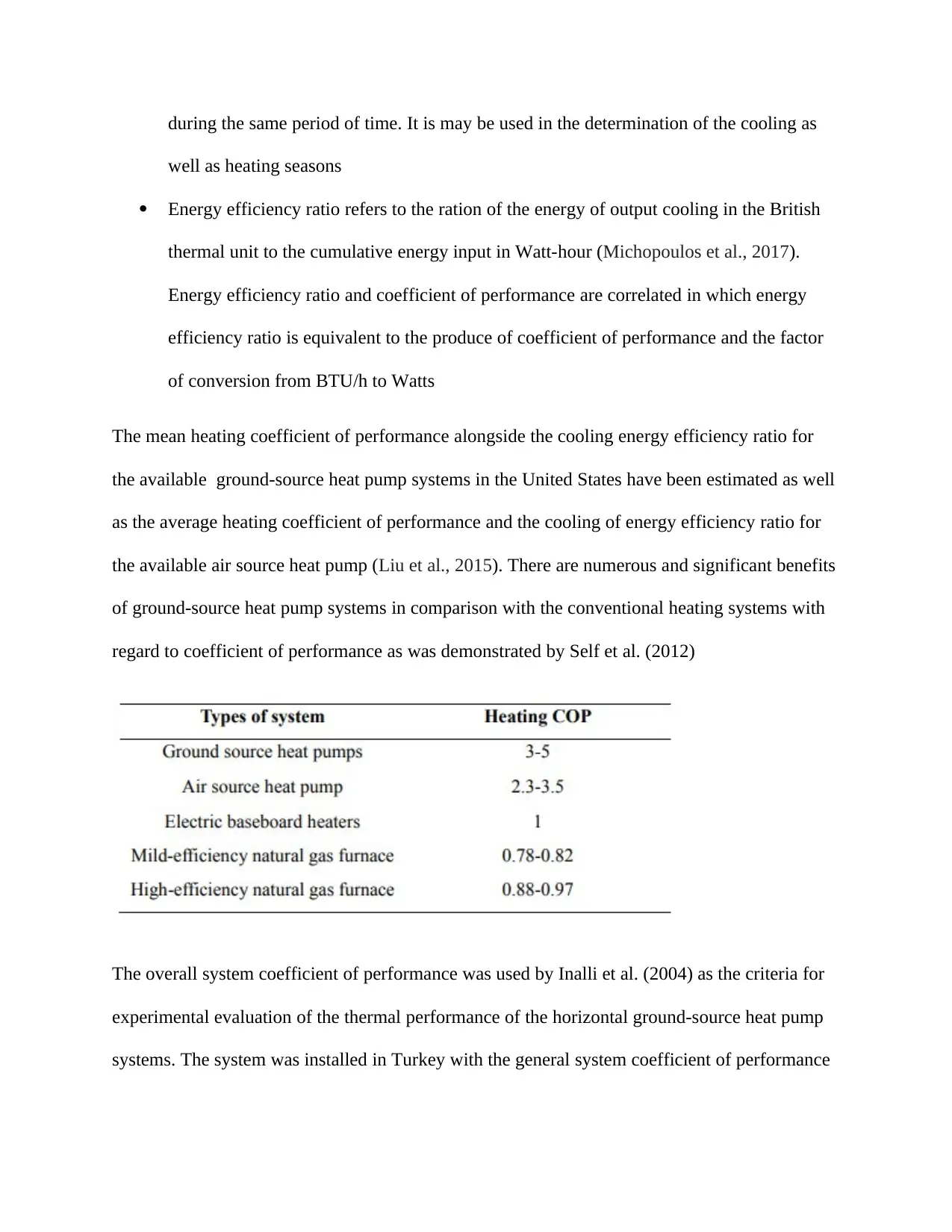
during the same period of time. It is may be used in the determination of the cooling as
well as heating seasons
Energy efficiency ratio refers to the ration of the energy of output cooling in the British
thermal unit to the cumulative energy input in Watt-hour (Michopoulos et al., 2017).
Energy efficiency ratio and coefficient of performance are correlated in which energy
efficiency ratio is equivalent to the produce of coefficient of performance and the factor
of conversion from BTU/h to Watts
The mean heating coefficient of performance alongside the cooling energy efficiency ratio for
the available ground-source heat pump systems in the United States have been estimated as well
as the average heating coefficient of performance and the cooling of energy efficiency ratio for
the available air source heat pump (Liu et al., 2015). There are numerous and significant benefits
of ground-source heat pump systems in comparison with the conventional heating systems with
regard to coefficient of performance as was demonstrated by Self et al. (2012)
The overall system coefficient of performance was used by Inalli et al. (2004) as the criteria for
experimental evaluation of the thermal performance of the horizontal ground-source heat pump
systems. The system was installed in Turkey with the general system coefficient of performance
well as heating seasons
Energy efficiency ratio refers to the ration of the energy of output cooling in the British
thermal unit to the cumulative energy input in Watt-hour (Michopoulos et al., 2017).
Energy efficiency ratio and coefficient of performance are correlated in which energy
efficiency ratio is equivalent to the produce of coefficient of performance and the factor
of conversion from BTU/h to Watts
The mean heating coefficient of performance alongside the cooling energy efficiency ratio for
the available ground-source heat pump systems in the United States have been estimated as well
as the average heating coefficient of performance and the cooling of energy efficiency ratio for
the available air source heat pump (Liu et al., 2015). There are numerous and significant benefits
of ground-source heat pump systems in comparison with the conventional heating systems with
regard to coefficient of performance as was demonstrated by Self et al. (2012)
The overall system coefficient of performance was used by Inalli et al. (2004) as the criteria for
experimental evaluation of the thermal performance of the horizontal ground-source heat pump
systems. The system was installed in Turkey with the general system coefficient of performance
⊘ This is a preview!⊘
Do you want full access?
Subscribe today to unlock all pages.

Trusted by 1+ million students worldwide
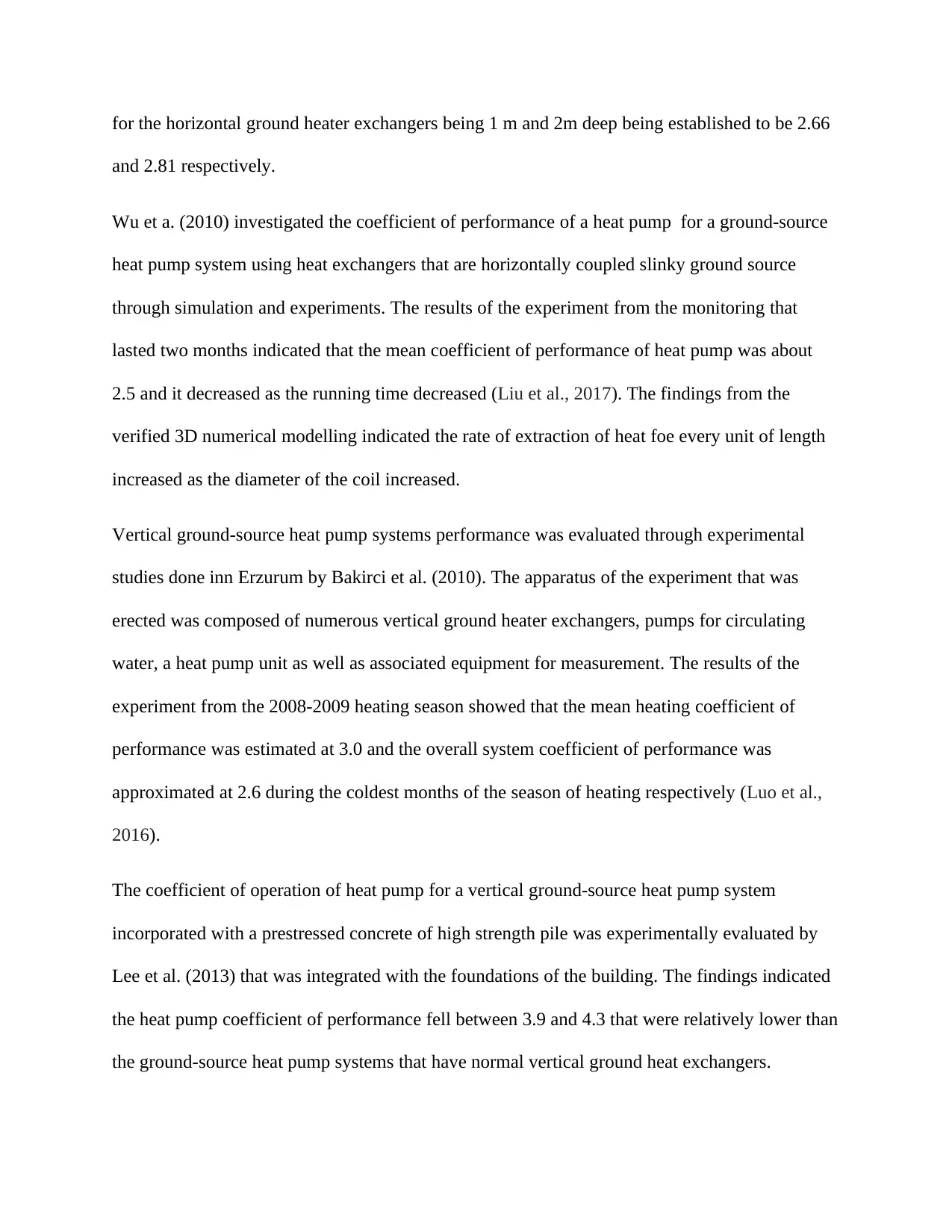
for the horizontal ground heater exchangers being 1 m and 2m deep being established to be 2.66
and 2.81 respectively.
Wu et a. (2010) investigated the coefficient of performance of a heat pump for a ground-source
heat pump system using heat exchangers that are horizontally coupled slinky ground source
through simulation and experiments. The results of the experiment from the monitoring that
lasted two months indicated that the mean coefficient of performance of heat pump was about
2.5 and it decreased as the running time decreased (Liu et al., 2017). The findings from the
verified 3D numerical modelling indicated the rate of extraction of heat foe every unit of length
increased as the diameter of the coil increased.
Vertical ground-source heat pump systems performance was evaluated through experimental
studies done inn Erzurum by Bakirci et al. (2010). The apparatus of the experiment that was
erected was composed of numerous vertical ground heater exchangers, pumps for circulating
water, a heat pump unit as well as associated equipment for measurement. The results of the
experiment from the 2008-2009 heating season showed that the mean heating coefficient of
performance was estimated at 3.0 and the overall system coefficient of performance was
approximated at 2.6 during the coldest months of the season of heating respectively (Luo et al.,
2016).
The coefficient of operation of heat pump for a vertical ground-source heat pump system
incorporated with a prestressed concrete of high strength pile was experimentally evaluated by
Lee et al. (2013) that was integrated with the foundations of the building. The findings indicated
the heat pump coefficient of performance fell between 3.9 and 4.3 that were relatively lower than
the ground-source heat pump systems that have normal vertical ground heat exchangers.
and 2.81 respectively.
Wu et a. (2010) investigated the coefficient of performance of a heat pump for a ground-source
heat pump system using heat exchangers that are horizontally coupled slinky ground source
through simulation and experiments. The results of the experiment from the monitoring that
lasted two months indicated that the mean coefficient of performance of heat pump was about
2.5 and it decreased as the running time decreased (Liu et al., 2017). The findings from the
verified 3D numerical modelling indicated the rate of extraction of heat foe every unit of length
increased as the diameter of the coil increased.
Vertical ground-source heat pump systems performance was evaluated through experimental
studies done inn Erzurum by Bakirci et al. (2010). The apparatus of the experiment that was
erected was composed of numerous vertical ground heater exchangers, pumps for circulating
water, a heat pump unit as well as associated equipment for measurement. The results of the
experiment from the 2008-2009 heating season showed that the mean heating coefficient of
performance was estimated at 3.0 and the overall system coefficient of performance was
approximated at 2.6 during the coldest months of the season of heating respectively (Luo et al.,
2016).
The coefficient of operation of heat pump for a vertical ground-source heat pump system
incorporated with a prestressed concrete of high strength pile was experimentally evaluated by
Lee et al. (2013) that was integrated with the foundations of the building. The findings indicated
the heat pump coefficient of performance fell between 3.9 and 4.3 that were relatively lower than
the ground-source heat pump systems that have normal vertical ground heat exchangers.
Paraphrase This Document
Need a fresh take? Get an instant paraphrase of this document with our AI Paraphraser
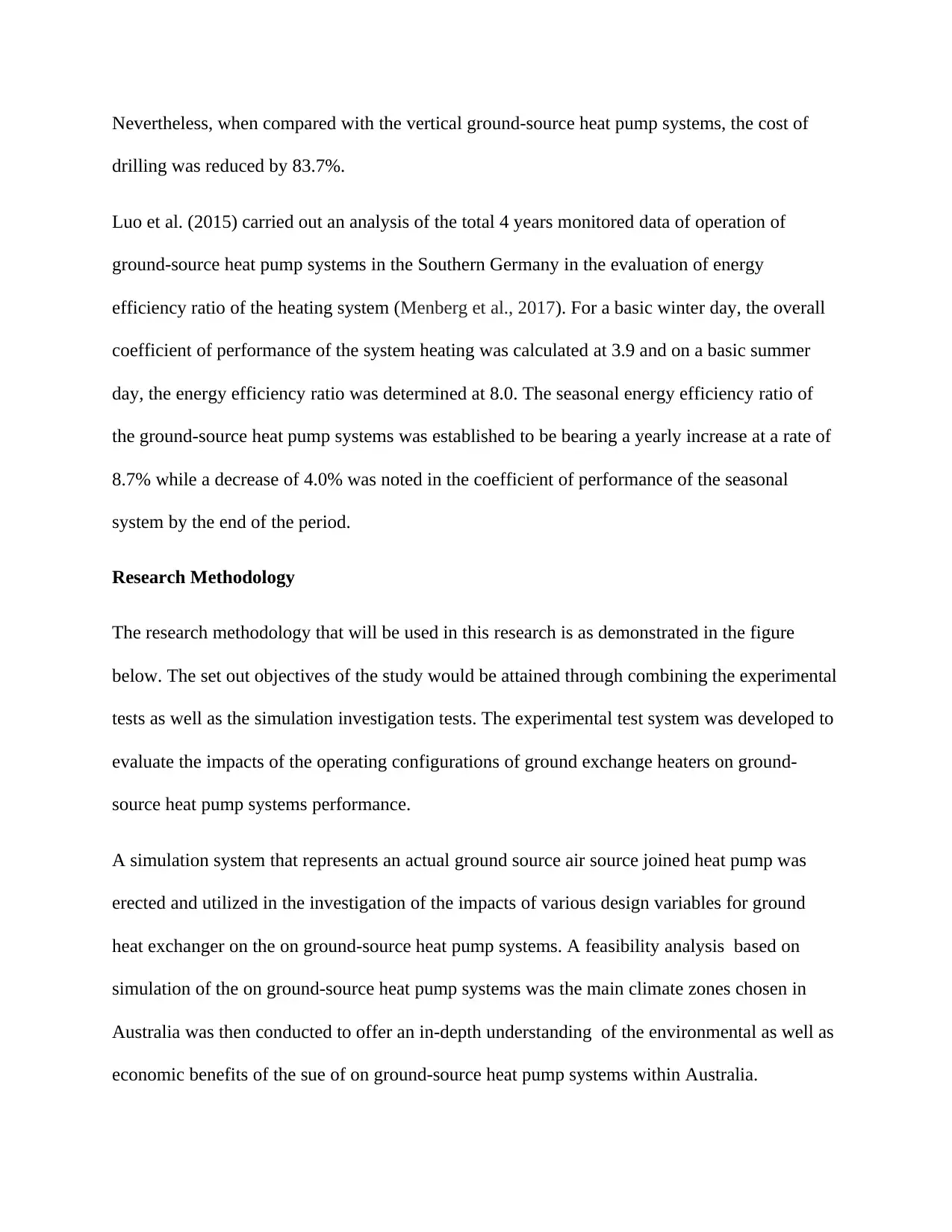
Nevertheless, when compared with the vertical ground-source heat pump systems, the cost of
drilling was reduced by 83.7%.
Luo et al. (2015) carried out an analysis of the total 4 years monitored data of operation of
ground-source heat pump systems in the Southern Germany in the evaluation of energy
efficiency ratio of the heating system (Menberg et al., 2017). For a basic winter day, the overall
coefficient of performance of the system heating was calculated at 3.9 and on a basic summer
day, the energy efficiency ratio was determined at 8.0. The seasonal energy efficiency ratio of
the ground-source heat pump systems was established to be bearing a yearly increase at a rate of
8.7% while a decrease of 4.0% was noted in the coefficient of performance of the seasonal
system by the end of the period.
Research Methodology
The research methodology that will be used in this research is as demonstrated in the figure
below. The set out objectives of the study would be attained through combining the experimental
tests as well as the simulation investigation tests. The experimental test system was developed to
evaluate the impacts of the operating configurations of ground exchange heaters on ground-
source heat pump systems performance.
A simulation system that represents an actual ground source air source joined heat pump was
erected and utilized in the investigation of the impacts of various design variables for ground
heat exchanger on the on ground-source heat pump systems. A feasibility analysis based on
simulation of the on ground-source heat pump systems was the main climate zones chosen in
Australia was then conducted to offer an in-depth understanding of the environmental as well as
economic benefits of the sue of on ground-source heat pump systems within Australia.
drilling was reduced by 83.7%.
Luo et al. (2015) carried out an analysis of the total 4 years monitored data of operation of
ground-source heat pump systems in the Southern Germany in the evaluation of energy
efficiency ratio of the heating system (Menberg et al., 2017). For a basic winter day, the overall
coefficient of performance of the system heating was calculated at 3.9 and on a basic summer
day, the energy efficiency ratio was determined at 8.0. The seasonal energy efficiency ratio of
the ground-source heat pump systems was established to be bearing a yearly increase at a rate of
8.7% while a decrease of 4.0% was noted in the coefficient of performance of the seasonal
system by the end of the period.
Research Methodology
The research methodology that will be used in this research is as demonstrated in the figure
below. The set out objectives of the study would be attained through combining the experimental
tests as well as the simulation investigation tests. The experimental test system was developed to
evaluate the impacts of the operating configurations of ground exchange heaters on ground-
source heat pump systems performance.
A simulation system that represents an actual ground source air source joined heat pump was
erected and utilized in the investigation of the impacts of various design variables for ground
heat exchanger on the on ground-source heat pump systems. A feasibility analysis based on
simulation of the on ground-source heat pump systems was the main climate zones chosen in
Australia was then conducted to offer an in-depth understanding of the environmental as well as
economic benefits of the sue of on ground-source heat pump systems within Australia.
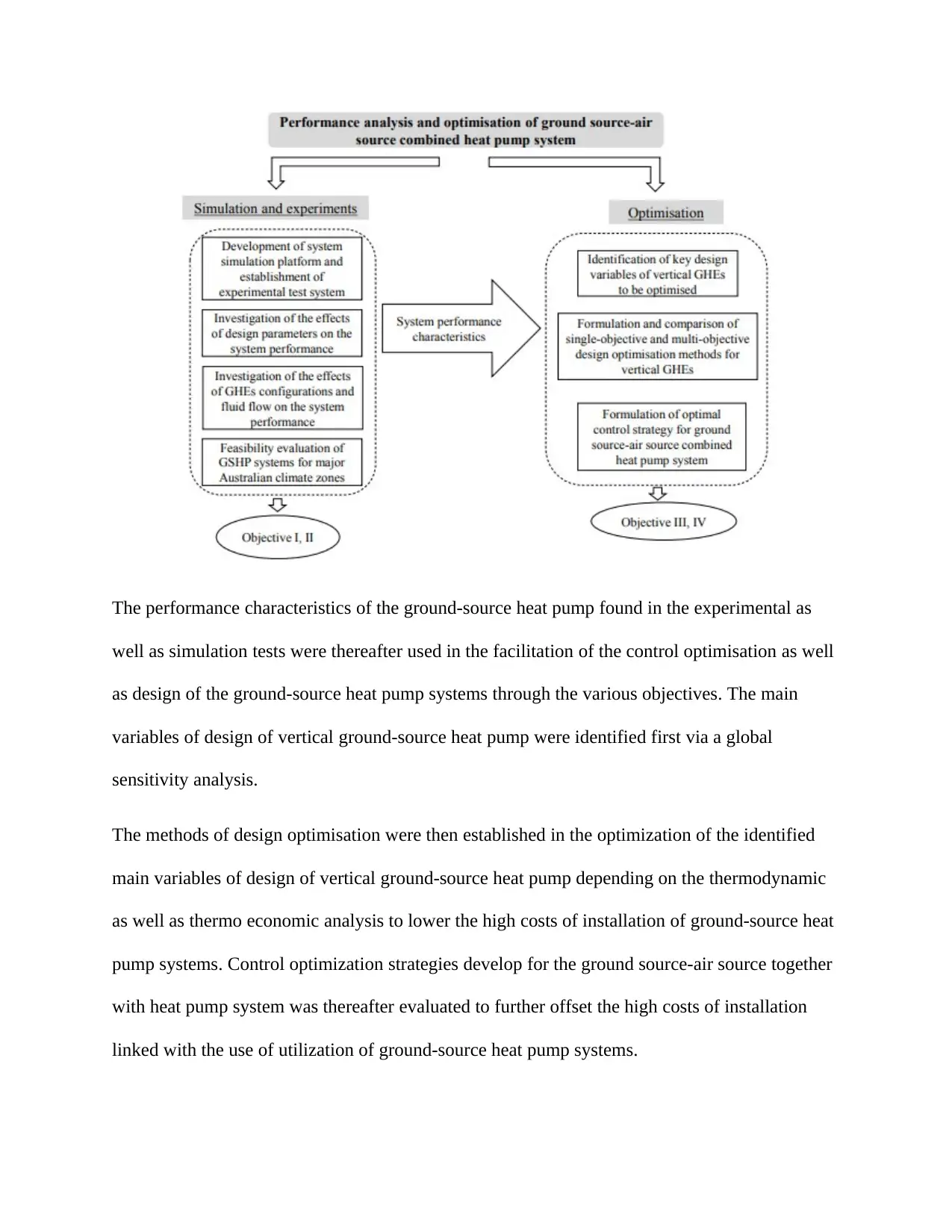
The performance characteristics of the ground-source heat pump found in the experimental as
well as simulation tests were thereafter used in the facilitation of the control optimisation as well
as design of the ground-source heat pump systems through the various objectives. The main
variables of design of vertical ground-source heat pump were identified first via a global
sensitivity analysis.
The methods of design optimisation were then established in the optimization of the identified
main variables of design of vertical ground-source heat pump depending on the thermodynamic
as well as thermo economic analysis to lower the high costs of installation of ground-source heat
pump systems. Control optimization strategies develop for the ground source-air source together
with heat pump system was thereafter evaluated to further offset the high costs of installation
linked with the use of utilization of ground-source heat pump systems.
well as simulation tests were thereafter used in the facilitation of the control optimisation as well
as design of the ground-source heat pump systems through the various objectives. The main
variables of design of vertical ground-source heat pump were identified first via a global
sensitivity analysis.
The methods of design optimisation were then established in the optimization of the identified
main variables of design of vertical ground-source heat pump depending on the thermodynamic
as well as thermo economic analysis to lower the high costs of installation of ground-source heat
pump systems. Control optimization strategies develop for the ground source-air source together
with heat pump system was thereafter evaluated to further offset the high costs of installation
linked with the use of utilization of ground-source heat pump systems.
⊘ This is a preview!⊘
Do you want full access?
Subscribe today to unlock all pages.

Trusted by 1+ million students worldwide
1 out of 16
Related Documents
Your All-in-One AI-Powered Toolkit for Academic Success.
+13062052269
info@desklib.com
Available 24*7 on WhatsApp / Email
![[object Object]](/_next/static/media/star-bottom.7253800d.svg)
Unlock your academic potential
Copyright © 2020–2025 A2Z Services. All Rights Reserved. Developed and managed by ZUCOL.





